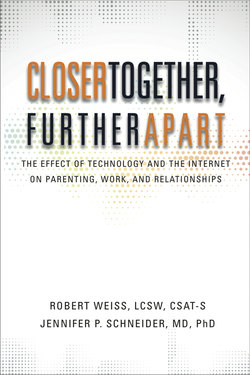Читать книгу Closer Together, Further Apart: The Effect of Technology and the Internet on Parenting, Work, and Relationships - Jennifer Schneider - Страница 9
На сайте Литреса книга снята с продажи.
The Great Leap
ОглавлениеMetaphorically speaking, humans got up off of their hands and knees, brushed off the muck and mire, and started not so much walking as sprinting with the advent of telecommunication—the transmission of organized and understandable electric signals over long distances. Happily, telecommunications provide the specificity that smoke signals, drums, and horns lacked. A telegram, for instance, could say, “Meet me in St. Louis at the Atwater Hotel, noon July 21, to discuss the marriage of your daughter to my son. STOP.” No mistaking the meaning of that communiqué.
The first useful telecommunications device, of course, was the telegraph, which Samuel Morse successfully tested in 1838. By late 1861 the first transcontinental telegraph system was established, and by the end of the nineteenth century telegraph cables connected every continent but Antarctica. Seemingly overnight, the transmission of information across great distances no longer relied on the vagaries of ships, carrier pigeons, and pony express riders. News, data, and other information could be transmitted almost instantaneously to virtually any major city. From there, it could be disseminated to others via the written and spoken word. In less than half a century the telegraph managed to connect virtually everyone on the planet.
In a relative flash, other telecommunications technologies arrived via telephone (1876), radio (1896), and television (1927).
Suddenly like magic, someone with the right expertise and devices could communicate with great masses of people all at the same time. Franklin Delano Roosevelt guided a struggling nation through the Great Depression with his inspirational “fireside talks” on the radio. Martin Luther King Jr. broadened the minds of not only the people directly in front of him, but millions of others who heard him on radio and saw him on television. Both of these men would rank highly on any list of “great leaders in history,” not only for their intelligent ideas and personal charisma, but because they understood and capitalized on the power of mass communication.
Toffler wrote in Future Shock about this communications explosion: “In our lifetime the boundaries have burst. Today the network of social ties is so tightly woven that the consequences of contemporary events radiate instantaneously around the world. A war in Vietnam alters basic political alignments in Peking, Moscow, and Washington, touches off protests in Stockholm, affects financial transactions in Zurich, triggers secret diplomatic moves in Algiers.”6 Note that Toffler penned this statement in 1970, decades before the Internet! Amazingly, he was referencing the now seemingly archaic, limited, and slow news sources known as newspapers, radio, and television.
Kenneth Boulding (1910–1993), whose quote we use at the beginning of this chapter, witnessed the rise of the telephone, radio, and television, along with the automobile, the airplane, and rocket ships. One could argue that his comment, “Almost as much has happened since I was born as happened before,” is quite the understatement.
| Time it Took for New Communication Technologies to Enter the Homes of 50 million people (US) | |
| Radio | 38 years |
| Television | 13 years |
| Internet | 4 years |
| Social networking | 16 months |
| Smartphone apps | 9 months |
